NCLEX Practice Exam 5 Questions And Answers (Latest Version)
Document Content and Description Below
NCLEX Practice Exam 5 (45 Items) Question 1 A nurse is administering IV furosemide to a patient admitted with congestive heart failure. After the infusion, which of the following symptoms is NOT exp... ected? Increased urinary output. Decreased edema. Decreased pain. Decreased blood pressure. Question 2 There are a number of risk factors associated with coronary artery disease. Which of the following is a modifiable risk factor? Obesity. Heredity. Gender. Age. Question 3 Tissue plasminogen activator (t-PA) is considered for treatment of a patient who arrives in the emergency department following onset of symptoms of myocardial infarction. Which of the following is a contraindication for treatment with t-PA? Worsening chest pain that began earlier in the evening. History of cerebral hemorrhage. History of prior myocardial infarction. Hypertension. . Question 4 Following myocardial infarction, a hospitalized patient is encouraged to practice frequent leg exercises and ambulate in the hallway as directed by his physician. Which of the following choices reflects the purpose of exercise for this patient? Increases fitness and prevents future heart attacks. Prevents bedsores. Prevents DVT (deep vein thrombosis). Prevent constipations. . Question 5 A patient arrives in the emergency department with symptoms of myocardial infarction, progressing to cardiogenic shock. Which of the following symptoms should the nurse expect the patient to exhibit with cardiogenic shock? Hypertension. Bradycardia. Bounding pulse. Confusion. . Question 6 A patient with a history of congestive heart failure arrives at the clinic complaining of dyspnea. Which of the following actions is the first the nurse should perform? Ask the patient to lie down on the exam table. Draw blood for chemistry panel and arterial blood gas (ABG). Send the patient for a chest x-ray. Check blood pressure. Question 6 Explanation: . Question 7 A clinic patient has recently been prescribed nitroglycerin for treatment of angina. He calls the nurse complaining of frequent headaches. Which of the following responses to the patient is correct? “Stop taking the nitroglycerin and see if the headaches improve.” “Go to the emergency department to be checked because nitroglycerin can cause bleeding in the brain.” “Headaches are a frequent side effect of nitroglycerine because it causes vasodilation.” “The headaches are unlikely to be related to the nitroglycerin, so you should see your doctor for further investigation.” Question 8 A patient received surgery and chemotherapy for colon cancer, completing therapy 3 months previously, and she is now in remission. At a follow-up appointment, she complains of fatigue following activity and difficulty with concentration at her weekly bridge games. Which of the following explanations could account for her symptoms? The symptoms may be the result of anemia caused by chemotherapy. The patient may be immunosuppressed. The patient may be depressed. The patient may be dehydrated. Question 9 A clinic patient has a hemoglobin concentration of 10.8 g/dL and reports sticking to a strict vegetarian diet. Which of the follow nutritional advice is appropriate? The diet is providing adequate sources of iron and requires no changes. The patient should add meat to her diet; a vegetarian diet is not advised. The patient should use iron cookware to prepare foods, such as dark green, leafy vegetables and legumes, which are high in iron. A cup of coffee or tea should be added to every meal. . Question 10 A hospitalized patient is receiving packed red blood cells (PRBCs) for treatment of severe anemia. Which of the following is the most accurate statement? Transfusion reaction is most likely immediately after the infusion is completed. PRBCs are best infused slowly through a 20g. IV catheter. PRBCs should be flushed with a 5% dextrose solution. A nurse should remain in the room during the first 15 minutes of infusion. Question 11 A patient who has received chemotherapy for cancer treatment is given an injection of Epoetin. Which of the following should reflect the findings in a complete blood count (CBC) drawn several days later? An increase in neutrophil count. An increase in hematocrit. An increase in platelet count. An increase in serum iron. Question 12 A patient is admitted to the hospital with suspected polycythemia vera. Which of the following symptoms is consistent with the diagnosis? Select all that applies. Weight loss. Increased clotting time. Hypertension. Headaches. Question 13 A nurse is caring for a patient with a platelet count of 20,000/microliter. Which of the following is an important intervention? Observe for evidence of spontaneous bleeding. Limit visitors to family only. Give aspirin in case of headaches. Impose immune precautions. Question 14 A nurse in the emergency department assesses a patient who has been taking long-term corticosteroids to treat renal disease. Which of the following is a typical side effect of corticosteroid treatment? Note: More than one answer may be correct. Hypertension. Cushingoid features. Hyponatremia. Low serum albumin. Question 15 A nurse is caring for patients in the oncology unit. Which of the following is the most important nursing action when caring for a neutropenic patient? Change the disposable mask immediately after use. Change gloves immediately after use. Minimize patient contact. Minimize conversation with the patient. . Question 16 A patient is undergoing the induction stage of treatment for leukemia. The nurse teaches family members about infectious precautions. Which of the following statements by family members indicates that the family needs more education? We will bring in books and magazines for entertainment. We will bring in personal care items for comfort. We will bring in fresh flowers to brighten the room. We will bring in family pictures and get well cards. Question 17 A nurse is caring for a patient with acute lymphoblastic leukemia (ALL). Which of the following is the most likely age range of the patient? 3-10 years. 25-35 years. 45-55 years. over 60 years. Question 18 A patient is admitted to the oncology unit for diagnosis of suspected Hodgkin’s disease. Which of the following symptoms is typical of Hodgkin’s disease? Painful cervical lymph nodes. Night sweats and fatigue. Nausea and vomiting. Weight gain. Question 19 The Hodgkin’s disease patient described in the question above undergoes a lymph node biopsy for definitive diagnosis. If the diagnosis of Hodgkin’s disease were correct, which of the following cells would the pathologist expect to find? Reed-Sternberg cells. Lymphoblastic cells. Gaucher’s cells. Rieder’s cells Question 20 A patient is about to undergo bone marrow aspiration and biopsy and expresses fear and anxiety about the procedure. Which of the following is the most effective nursing response? Warn the patient to stay very still because the smallest movement will increase her pain. Encourage the family to stay in the room for the procedure. Stay with the patient and focus on slow, deep breathing for relaxation. Delay the procedure to allow the patient to deal with her feelings. Question 21 A 43-year-old African American male is admitted with sickle cell anemia. The nurse plans to assess circulation in the lower extremities every 2 hours. Which of the following outcome criteria would the nurse use? Body temperature of 99°F or less Toes moved in active range of motion Sensation reported when soles of feet are touched Capillary refill of < 3 seconds Question 22 A 30-year-old male from Haiti is brought to the emergency department in sickle cell crisis. What is the best position for this client? Side-lying with knees flexed Knee-chest High Fowler’s with knees flexed Semi-Fowler’s with legs extended on the bed Question 23 A 25-year-old male is admitted in sickle cell crisis. Which of the following interventions would be of highest priority for this client? Taking hourly blood pressures with mechanical cuff Encouraging fluid intake of at least 200mL per hour Position in high Fowler’s with knee gatch raised Administering Tylenol as ordered Question 24 Which of the following foods would the nurse encourage the client in sickle cell crisis to eat? Peaches Cottage cheese Popsicle Lima beans Question 25 A newly admitted client has sickle cell crisis. The nurse is planning care based on assessment of the client. The client is complaining of severe pain in his feet and hands. The pulse oximetry is 92. Which of the following interventions would be implemented first? Assume that there are orders for each intervention. Adjust the room temperature Give a bolus of IV fluids Start O2 Administer meperidine (Demerol) 75 mg IV push Question 26 The nurse is instructing a client with iron-deficiency anemia. Which of the following meal plans would the nurse expect the client to select? Roast beef, gelatin salad, green beans, and peach pie Chicken salad sandwich, coleslaw, French fries, ice cream Egg salad on wheat bread, carrot sticks, lettuce salad, raisin pie Pork chop, creamed potatoes, corn, and coconut cake Question 27 Clients with sickle cell anemia are taught to avoid activities that cause hypoxia and hypoxemia. Which of the following activities would the nurse recommend? A family vacation in the Rocky Mountains Chaperoning the local boys club on a snow-skiing trip Traveling by airplane for business trips A bus trip to the Museum of Natural History Question 28 The nurse is conducting an admission assessment of a client with vitamin B12 deficiency. Which of the following would the nurse include in the physical assessment? Palpate the spleen Take the blood pressure Examine the feet for petechiae Examine the tongue Question 29 An African American female comes to the outpatient clinic. The physician suspects vitamin B12 deficiency anemia. Because jaundice is often a clinical manifestation of this type of anemia, what body part would be the best indicator? Conjunctiva of the eye Soles of the feet Roof of the mouth Shins Question 30 The nurse is conducting a physical assessment on a client with anemia. Which of the following clinical manifestations would be most indicative of the anemia? BP 146/88 Respirations 28 shallow Weight gain of 10 pounds in 6 months Pink complexion Question 31 The nurse is teaching the client with polycythemia vera about prevention of complications of the disease. Which of the following statements by the client indicates a need for further teaching? “I will drink 500mL of fluid or less each day.” “I will wear support hose when I am up.” “I will use an electric razor for shaving.” “I will eat foods low in iron.” . Question 32 A 33-year-old male is being evaluated for possible acute leukemia. Which of the following would the nurse inquire about as a part of the assessment? The client collects stamps as a hobby. The client recently lost his job as a postal worker. The client had radiation for treatment of Hodgkin’s disease as a teenager. The client’s brother had leukemia as a child. Question 33 An African American client is admitted with acute leukemia. The nurse is assessing for signs and symptoms of bleeding. Where is the best site for examining for the presence of petechiae? The abdomen The thorax The earlobes The soles of the feet Question 34 A client with acute leukemia is admitted to the oncology unit. Which of the following would be most important for the nurse to inquire? “Have you noticed a change in sleeping habits recently?” “Have you had a respiratory infection in the last 6 months?” “Have you lost weight recently?” “Have you noticed changes in your alertness?” Question 35 Which of the following would be the priority nursing diagnosis for the adult client with acute leukemia? Oral mucous membrane, altered related to chemotherapy Risk for injury related to thrombocytopenia Fatigue related to the disease process Interrupted family processes related to life-threatening illness of a family member Question 36 A 21-year-old male with Hodgkin’s lymphoma is a senior at the local university. He is engaged to be married and is to begin a new job upon graduation. Which of the following diagnoses would be a priority for this client? Sexual dysfunction related to radiation therapy Anticipatory grieving related to terminal illness Tissue integrity related to prolonged bed rest Fatigue related to chemotherapy Question 37 A client has autoimmune thrombocytopenic purpura. To determine the client’s response to treatment, the nurse would monitor: Platelet count White blood cell count Potassium levels Partial prothrombin time (PTT) Question 38 The home health nurse is visiting a client with autoimmune thrombocytopenic purpura (ATP). The client’s platelet count currently is 80, It will be most important to teach the client and family about: Bleeding precautions Prevention of falls Oxygen therapy Conservation of energy Question 39 A client with a pituitary tumor has had a transsphenoidal hypophysectomy. Which of the following interventions would be appropriate for this client? Place the client in Trendelenburg position for postural drainage Encourage coughing and deep breathing every 2 hours Elevate the head of the bed 30° Encourage the Valsalva maneuver for bowel movements Question 40 The client with a history of diabetes insipidus is admitted with polyuria, polydipsia, and mental confusion. The priority intervention for this client is: Measure the urinary output Check the vital signs Encourage increased fluid intake Weigh the client Question 41 A client with hemophilia has a nosebleed. Which nursing action is most appropriate to control the bleeding? Place the client in a sitting position with the head hyperextended Pack the nares tightly with gauze to apply pressure to the source of bleeding Pinch the soft lower part of the nose for a minimum of 5 minutes Apply ice packs to the forehead and back of the neck . Question 42 A client has had a unilateral adrenalectomy to remove a tumor. To prevent complications, the most important measurement in the immediate postoperative period for the nurse to take is: Blood pressure Temperature Output Specific gravity . Question 43 A client with Addison’s disease has been admitted with a history of nausea and vomiting for the past 3 days. The client is receiving IV glucocorticoids (Solu-Medrol). Which of the following interventions would the nurse implement? Glucometer readings as ordered Intake/output measurements Sodium and potassium levels monitored Daily weights Question 44 A client had a total thyroidectomy yesterday. The client is complaining of tingling around the mouth and in the fingers and toes. What would the nurses’ next action be? Obtain a crash cart Check the calcium level Assess the dressing for drainage Assess the blood pressure for hypertension Question 45 A 32-year-old mother of three is brought to the clinic. Her pulse is 52, there is a weight gain of 30 pounds in 4 months, and the client is wearing two sweaters. The client is diagnosed with hypothyroidism. Which of the following nursing diagnoses is of highest priority? Impaired physical mobility related to decreased endurance Hypothermia r/t decreased metabolic rate Disturbed thought processes r/t interstitial edema Decreased cardiac output r/t bradycardia . [Show More]
Last updated: 1 year ago
Preview 1 out of 20 pages
Instant download
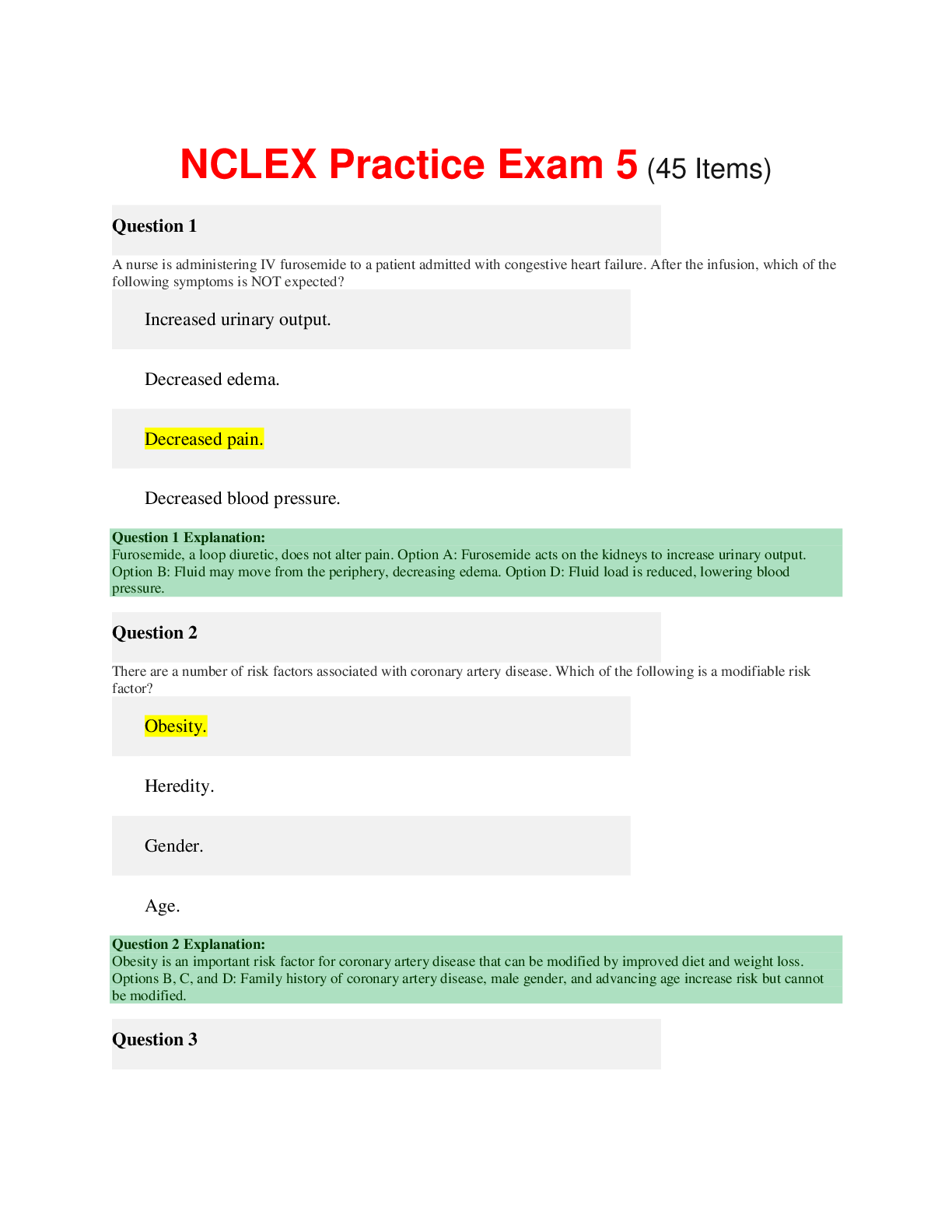
Buy this document to get the full access instantly
Instant Download Access after purchase
Add to cartInstant download
Reviews( 0 )
Document information
Connected school, study & course
About the document
Uploaded On
Sep 08, 2020
Number of pages
20
Written in
Additional information
This document has been written for:
Uploaded
Sep 08, 2020
Downloads
0
Views
77





.png)


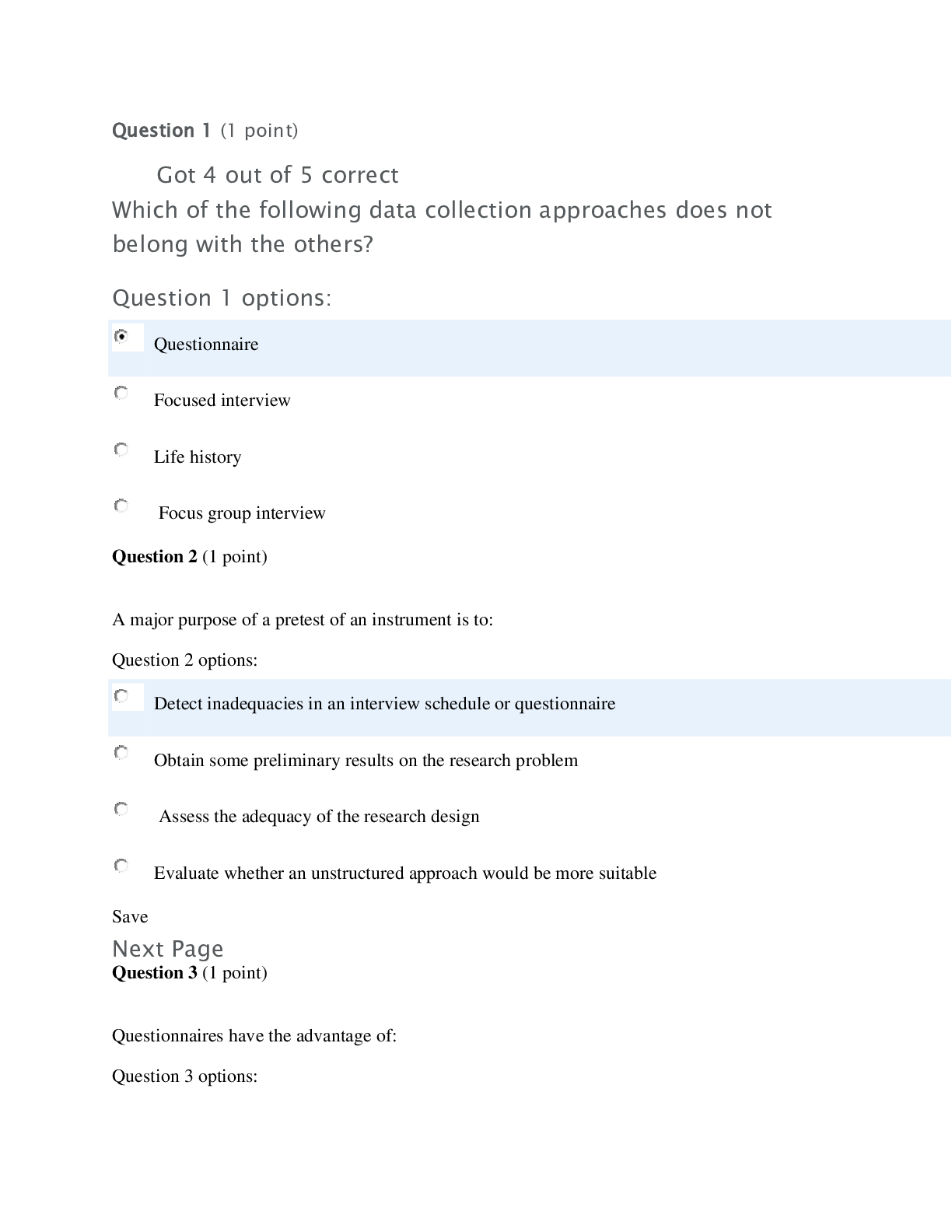


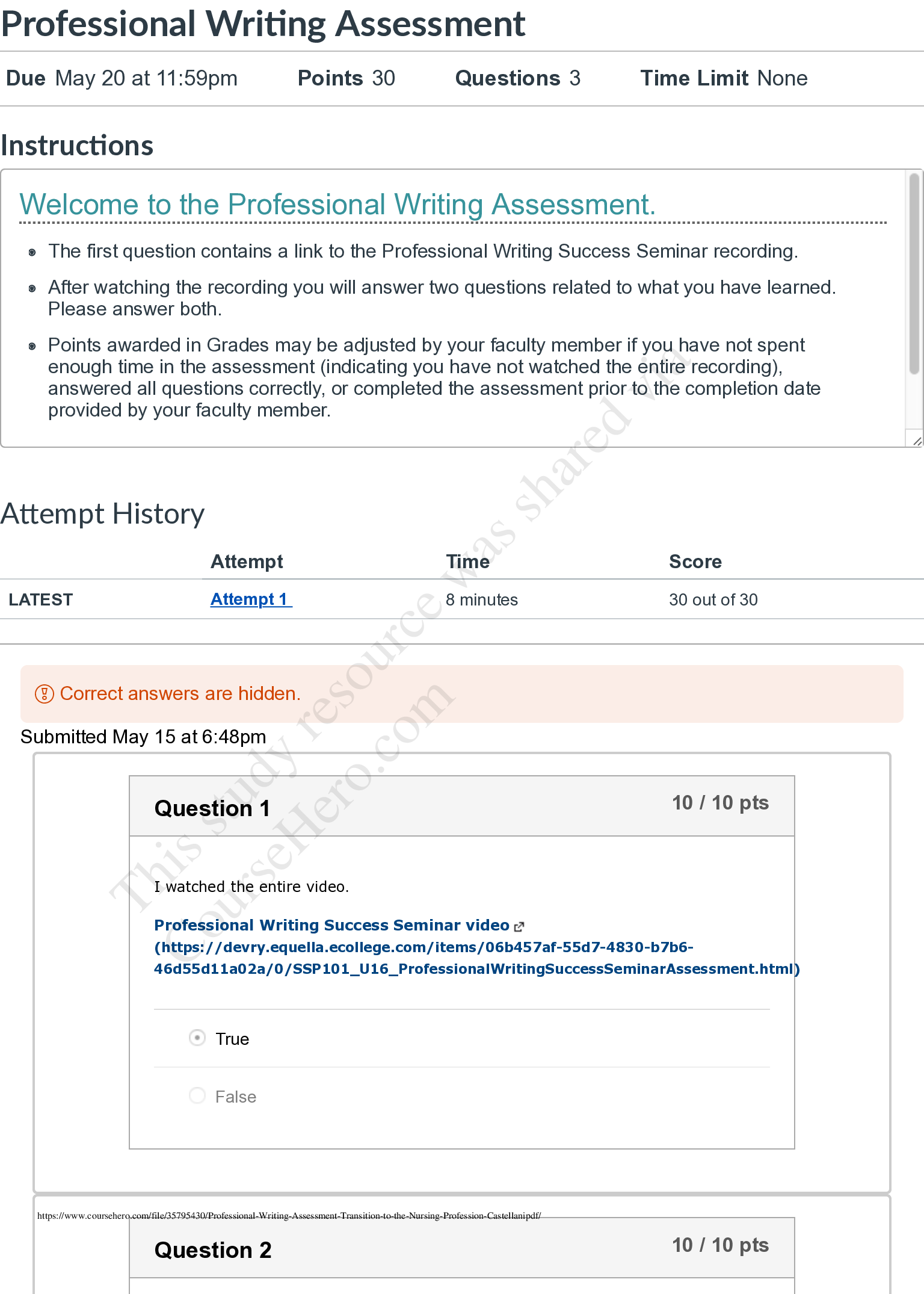
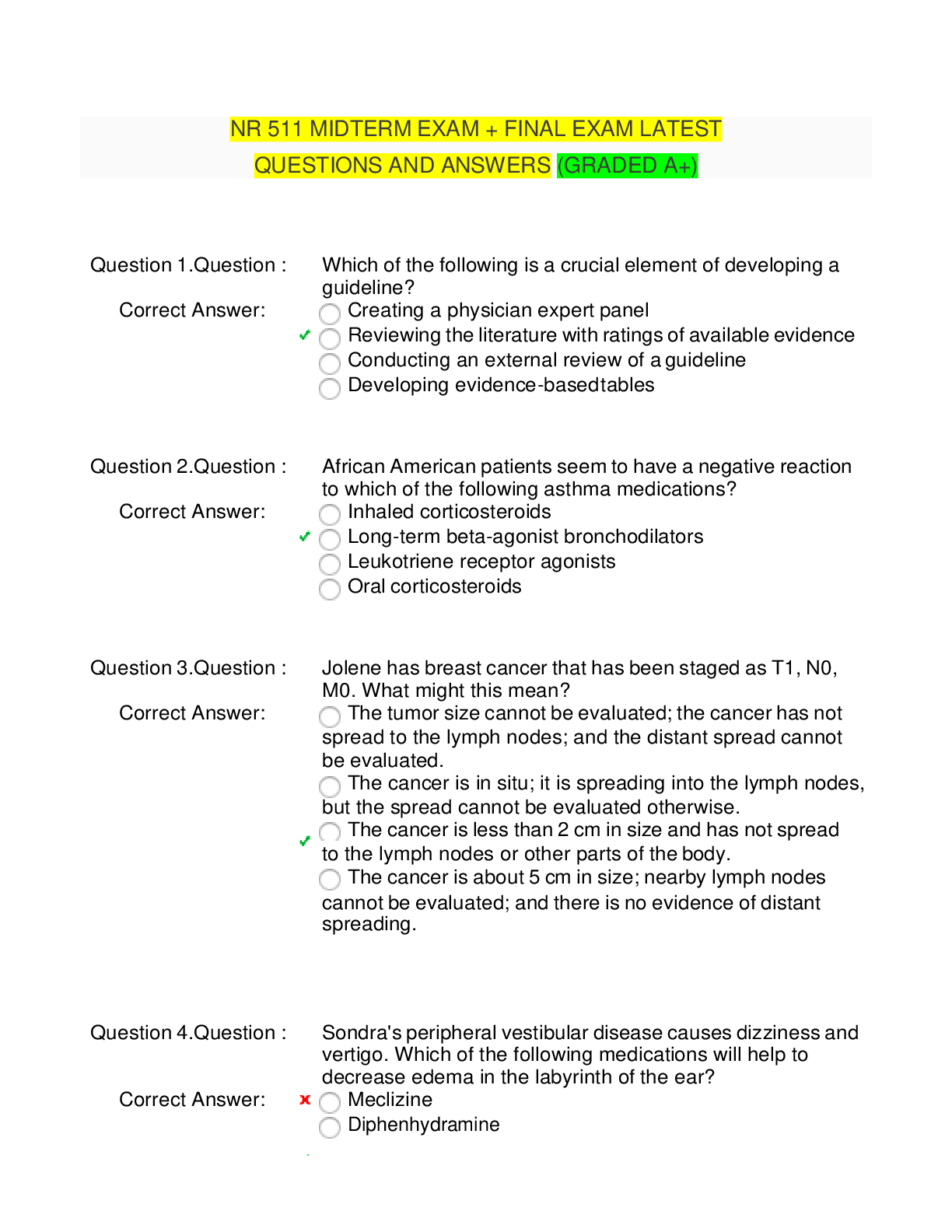

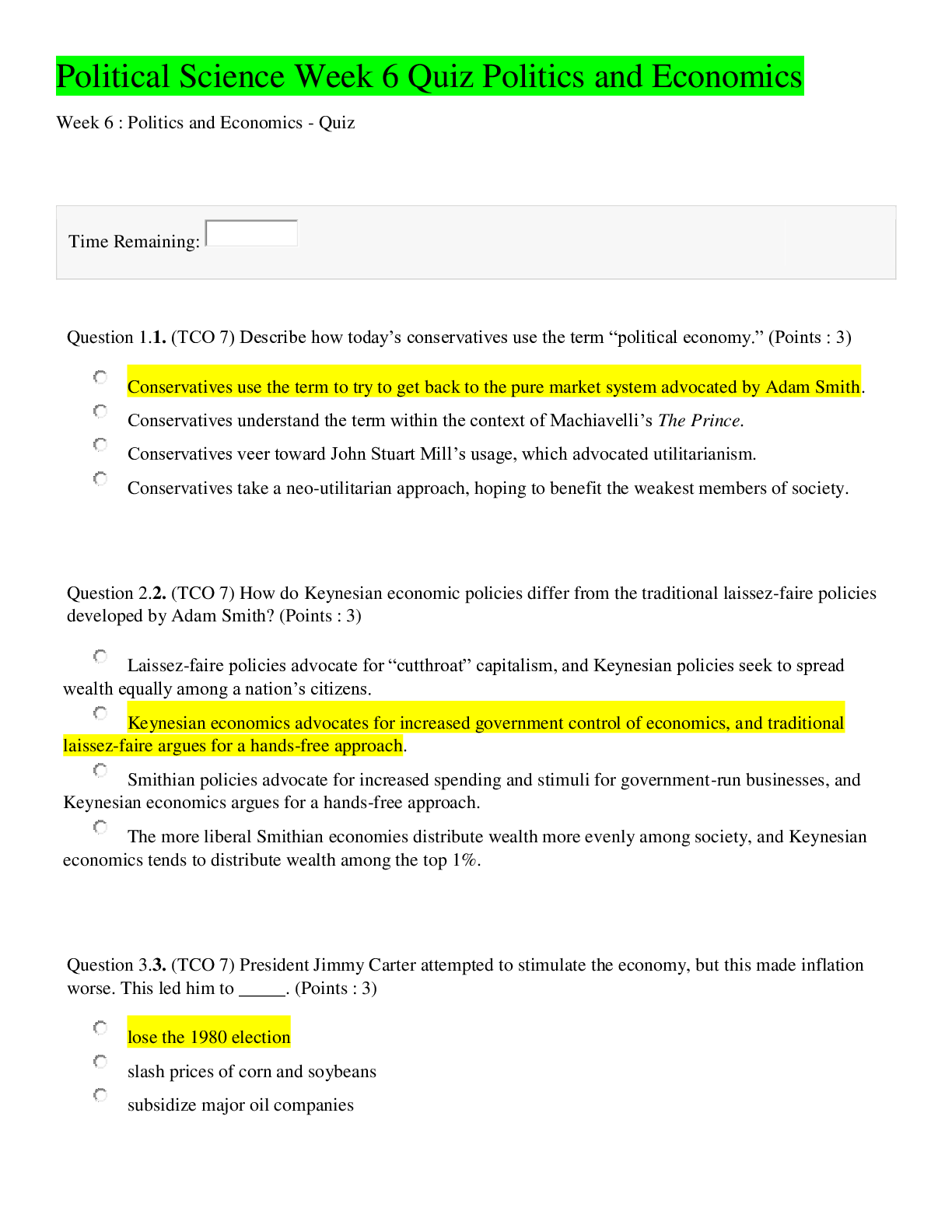



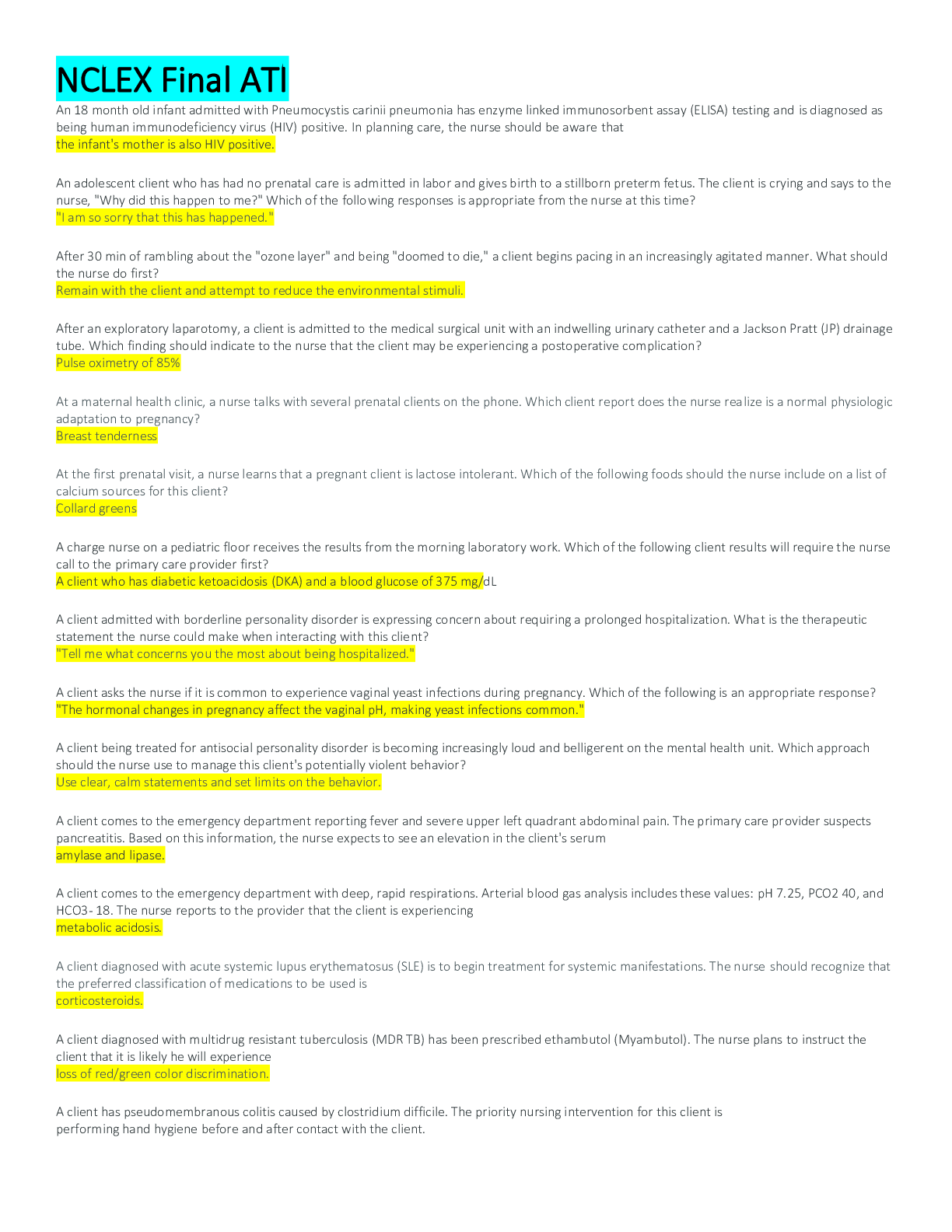
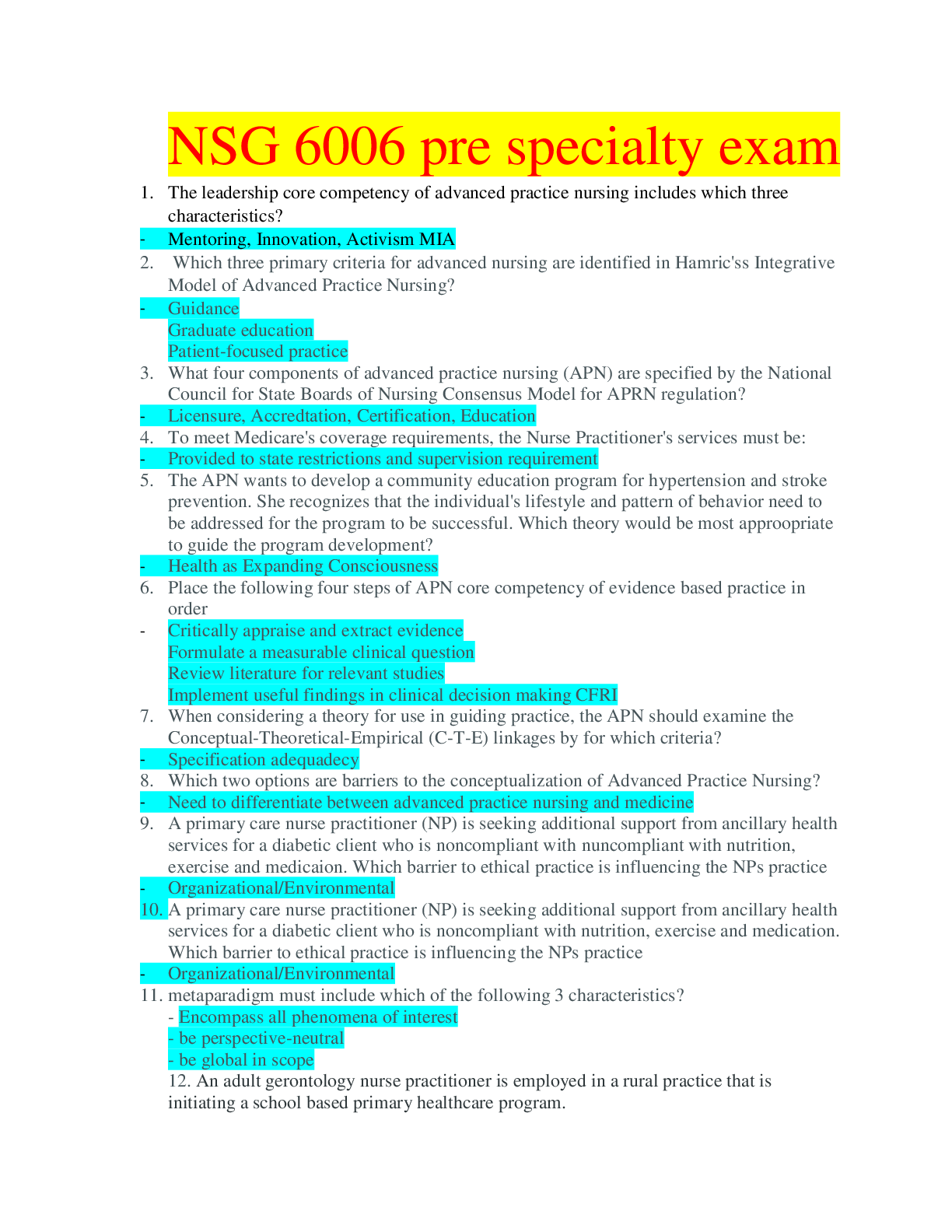
.png)
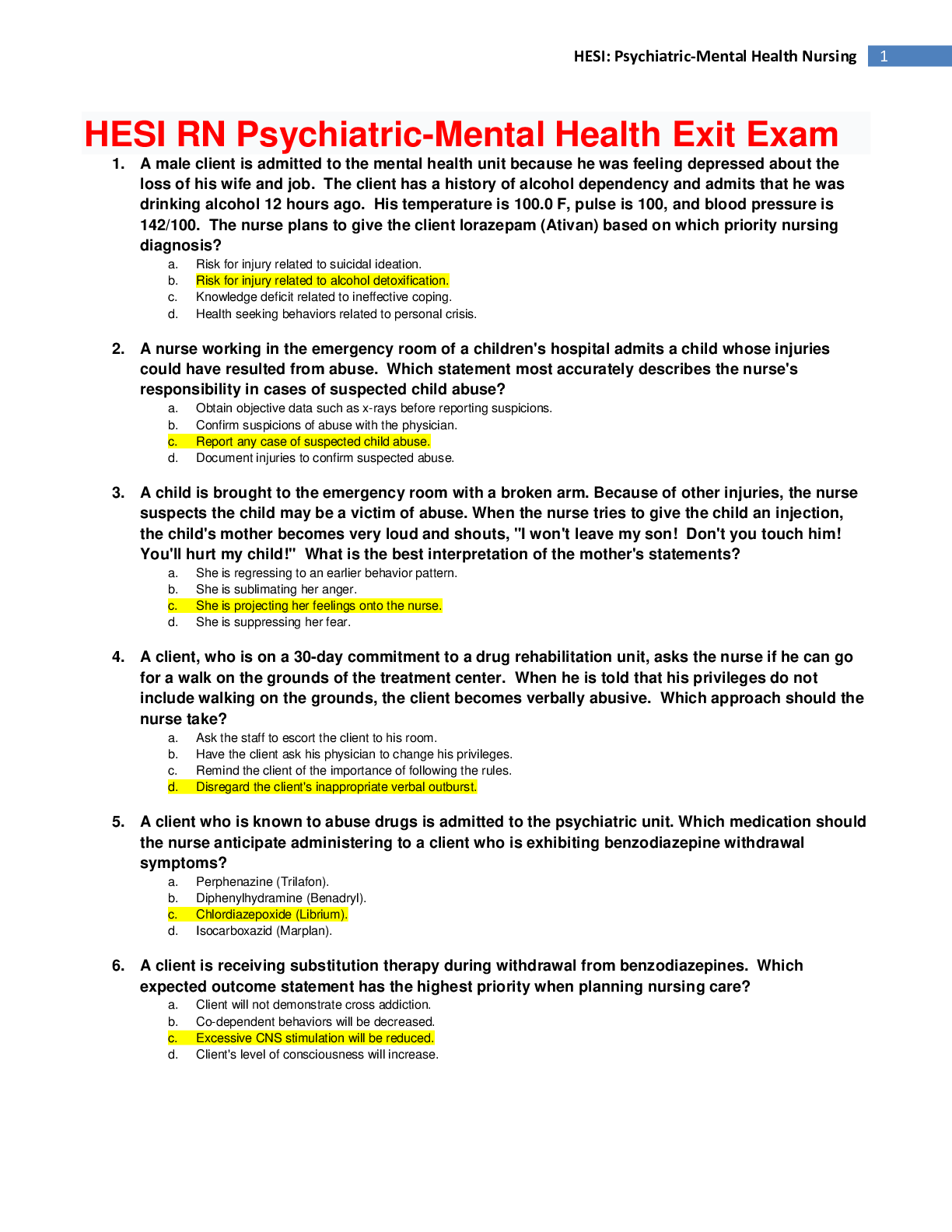
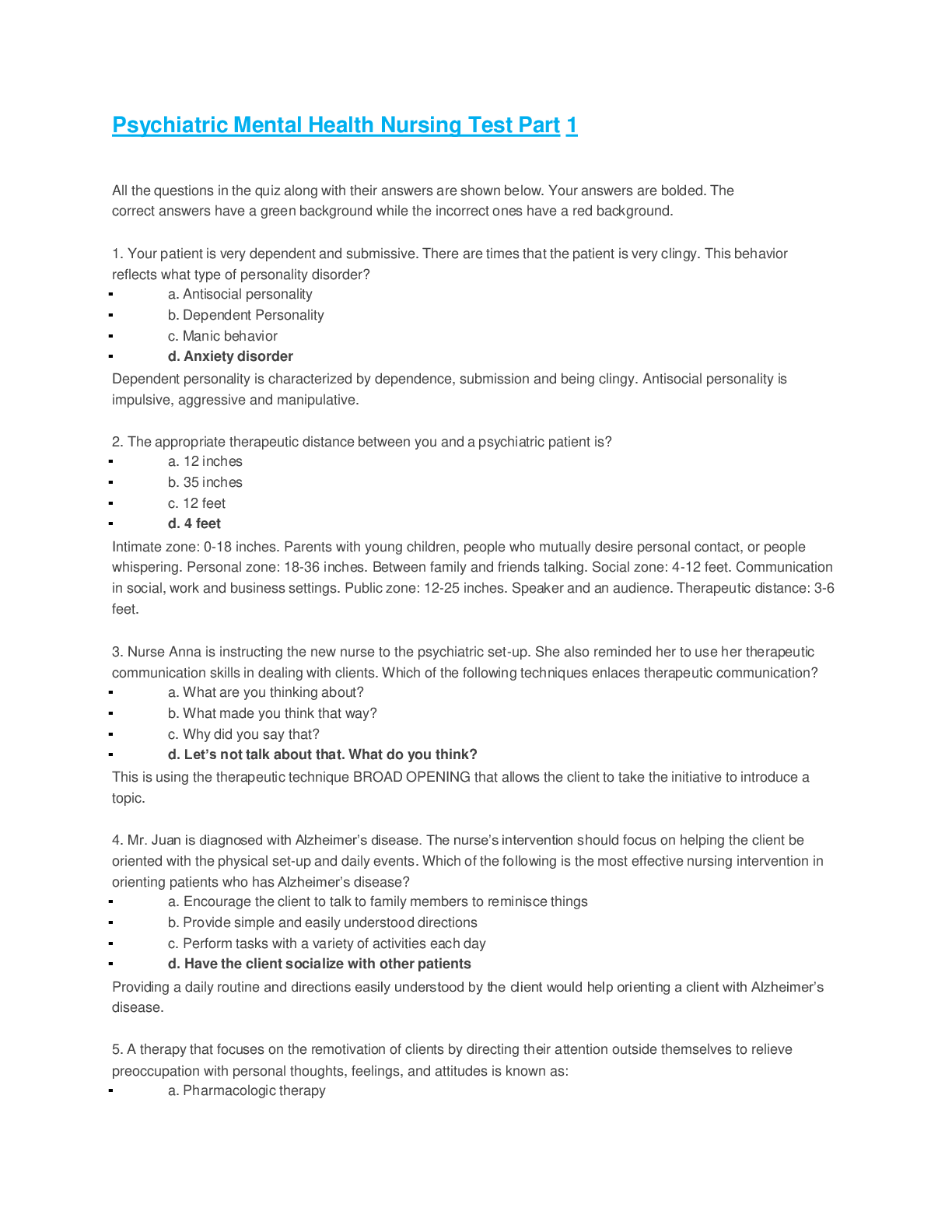
 – South university Savannah.png)

